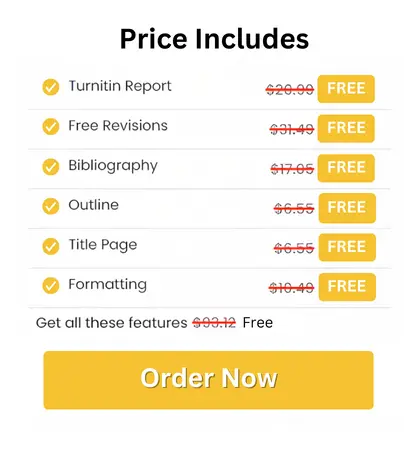
PRJ5002 Enterprise and Resource Planning Case Study 4 Sample
Assessment Task
Implementation of employee suggestion program: A case study of the Middle East health- care service company
Learning Outcomes
After studying this case, the students should be able to: explain the importance of employee engagement; illustrate the role of the participatory management style in an organizational context; discuss why managers may use engagement practices to operate effectively in businesses to lead change and innovation; identify the critical success factors, barriers and outcomes of employee involvement in driving high performance; and discuss the dilemma faced by the managers in the emerging economies while driving the momentum of excellence in the long run.
Students need to support their answers with further references to comprehensively address the questions in a critical manner. In addition, a summary of recently published articles relevant to project human resources, communications and stakeholder management need to be added to the discussion where appropriate and relevant.
Solution
1. Introduction
The healthcare sector in the Middle East has been growing rapidly and transforming. Key drivers include an aging population that is in dire need of advanced services, medical tourism on the rise due to global recognition of regional facilities, and rapid technological changes that are revolutionizing patient care. Additionally, the growing focus on the delivery of quality healthcare services encourages organizations to find innovative ways to ensure efficiency, sustainability, and excellence.
NOVA has become one of the leading healthcare providers and pledged its duty to stay ahead within the industry. It is here that NOVA recognized the importance of its staff and introduced an innovative employee suggestion initiative called the Minara Program. This would enable creativity and expertise from their employees to be generated for innovative improvement in service delivery that matched the organization's objectives with the wider vision of healthcare excellence (Mehrajunnisa et al., 2018).
The Minara Program was a strategic response to the Middle East Healthcare Vision 2030, which places innovation at the heart of development goals. NOVA aspired to involve employees in meaningfully addressing operational challenges while nurturing a culture of collaboration and continuous improvement (Isenor et al., 2024). The report investigates the implementation and outcomes of the program, focusing on questions such as the importance of employee engagement, the role of participatory management, challenges faced by managers in emerging economies, and barriers and enablers of employee involvement. This report explores how empowering employees can be one of the cornerstones for achieving organizational excellence and sustainability.
2. Importance of Employee Engagement
Employee engagement drives any organization to success. Improved productivity, sparking of creativity, and a spirit of commitment create an enabling environment that stimulates individual and team growth. In a nutshell, the Minara Program presents an illustrative case on how effective employee engagement would bring several organizational benefits. Through effective employee engagement, NOVA has been able to tap into their innovative capability and perspective to resolve its operational issues and serve better healthcare to its beneficiaries. It has been observed that actively engaged employees contribute a lot to enhancing operational efficiencies. For example, some staff, through the Minara Program, came forward with solutions aimed at reducing wait times and smoothing procedural workflows for patients; therefore, this has gone ahead to improve service delivery (Szilvassy and Širok, 2022). Further, individual performance goals that are in line with organizational objectives have been in place, meaning each employee feels he has a purpose and a sense of belonging, thus ensuring deeper for Deakin university assignment help commitment to continuous improvement and innovation at NOVA (Mehrajunnisa et al., 2018).
In addition to all the operational benefits, employee engagement will improve the organizational culture. By encouraging active participation, NOVA drew upon its workforce's ingenuity but also created an environment of collaboration and openness. In this way, the company was recognized regionally as one of the best health care providers. Employee engagement at NOVA serves to illustrate how the release of workforce collective intelligence delivers sustained excellence and innovation.
3. The Role of Participatory Management in an Organization
3.1 Definition and Benefits
Participatory management is about taking the process of owning-up through the involvement of rank and file in some ways into decision-making. By implication, it was seen to provide an environment in which every team player acts together and is also integrally responsible for organizational outcomes (Vargas et al., 2020). Part of the participatory management happening at NOVA became one of the most important ingredients with:
• Decentralized Decision-Making: A digital platform allowed employees to submit ideas directly, contributing to operational improvements and fostering innovation.
• Encouraging collaboration across departments: Departments were co-operating with each other in a better way without any hierarchical barrier, ensuring a much more cohesive group.
• Improvement in Employee Morale: Recognition and rewarding innovative contributions indeed helped motivate them to participate more in the improvement initiatives (Larasati and Martono, 2020).
• Improved Operational Efficiency: Many employee ideas resolved workflow bottlenecks and further streamlined processes to ensure better resource utilization.
• Innovation-Fostering: Participatory management greatly encourages employees to think out of the box and work out solutions for complex business problems (Cennamo, Oliveira and Zejnilovic, 2022).
• Building Organizational Trust: It is the transparency in decision-making that makes the employees strong in their relationship with leadership.
3.2 Implementation at NOVA
NOVA's Minara Program has been one example of participatory management put to good practice. Examples include:
• Comprehensive Training Programs: The employees, through such training programs as decision-making and innovation techniques, came well-armed for challenges (Shen et al., 2022).
• Accessible Lines of Communication: Ideas were shared through the intranet portal, availing constructive feedback loops.
• Rewards Mechanism: There is a financial and nonfinancial reward attached to making valuable contributions, thus improving engagement.
• Improved Transparency: The utilization of available tools like Johari Window has been critical in explaining better communication toward an organizational culture of transparency (Yun, 2024). This helped NOVA develop a working environment of collaboration and innovation through which it continued on the trajectory toward health care excellence.
4. Engagement Practices for Change and Innovation.
Engagement practices are strategically used by managers to navigate organizational change and drive innovation effectively. These practices not only increase the adaptability of an organization but also contribute significantly to strengthening its competitive advantage in fast-moving markets. Key contributions of engagement practices include:
• Encouraging Innovation: By providing an environment that values creativity, managers can tap into the potential in employees to bring forth actionable solutions. This approach enhances operational efficiency many times over and introduces ground-breaking innovations aligned with strategic goals (Moradinasab, 2021).
• Increased Adaptability: The active participation of employees prepares the workforce for acceptance of changes within the organization. This reduces resistance and provides smoother transitions in times of change, building resilience within the organization.
• Achieving Strategic Objectives: The practice of engagement aligns individual employees' efforts to the broader-based goals of the organization, some of which are identified within the Middle East Healthcare Vision 2030. That means every contribution at an individual level ensures progress on a team level toward attaining a long-term vision.
• Fostering Team Collaboration: The initiative of collaborative engagement brings together people from diverse backgrounds and departments to understand how to effectively address various complex organizational challenges. These practices ensure that the workforce is united and resourceful by encouraging teamwork (Klaic, Burtscher and Jonas, 2020).
• Optimizing Problem-Solving: Engaged employees provide a range of perspectives and insights, facilitating comprehensive and innovative solutions to operational issues. This diversity in problem-solving approaches fosters innovation and adaptability.
5. Critical Success Factors, Barriers, and Outcomes of Employee Involvement
5.1 Critical Success Factors: Various reasons might account for the success of the Minara Program:
Leadership Commitment: Evidently, solid support from the highest levels of management helped to drive employee engagement. With active endorsement from positions of leadership, the program would not leave them out of step as regards the objectives of the business organization and would provide a fundamentally trusting and supportive environment considering the circumstances (Kwon and Jeon, 2020).
Transparency of Processes: Easy access to an online digital portal for submissions, along with lucidly stated evaluation criteria, ensured that every employee suggestion was assessed fairly and transparently. This transparency further motivated employees to contribute ideas, as they knew these would be evaluated equitably.
The mechanism for Recognition: A strong reward mechanism, financial and public acknowledgment enabled people to be motivated enough towards participating in the program. Further, it reinforced in them 'the importance of his / her contribution' towards success.
Alignment with Strategic Goals: Introducing employees' suggestions into NOVA's strategic framework made the program relevant. Suggestions that fell within the Middle East Healthcare Vision 2030 further enforced its effect (Mehrajunnisa et al., 2018).
Empowerment by Training: Extensive training developed the employees' skills and instilled in them a certain level of confidence to think innovatively, thus creating ownership and participation.
5.2 Barriers: Despite the success, there were various challenges which faced the Minara Program:
Limited Resources: Several of the employee ideas had to be shelved due to budgetary constraints, and the scalability and effectiveness of the program suffered as a result.
Traditional Resistance: The setup of hierarchical practices was inhibiting the adoption of participation approaches. It took time and time for employees and managers alike to adapt to the cultural change promoted by the intervention program.
Communication Gaps: Insufficient promotional efforts made the employees very less aware of the objectives and benefits of the program, thus reducing the level of engagement (Jeon, 2021).
Bias in Idea Evaluation: The centralized decision-making process sometimes led to biases, which created the perception of unfairness regarding how ideas were prioritized.
Time Constraints: Employees had to balance their regular responsibilities with participation in the program, which reduced both the frequency and quality of contributions.
5.3 Outcomes: The results of the Minara Program speak volumes about its transformative impacts at NOVA:
Improvement in Operational Efficiency: First hand employee suggestions lessened patients' wait times and rationalized workflow and generally ensured that delivery became effective.
Improved Morale and Retention: Recognition given to the employees about their contribution installs a sense of belonging and therefore generates loyalty, which then leads to better retention rates with improved job satisfaction (Gomathy et al., 2022).
Reputation for Innovation: Meeting these needs through the success of the program positioned NOVA as an industry leader in innovation for healthcare, reaping accreditations from the perspective of the industry and putting NOVA at a further competitive advantage.
Cost Savings: The implementation of employee-driven ideas greatly ensured cost savings, hence optimizing resources and financial performance.
Cultural Shift: The program promoted a more inclusive and collaborative work environment, paving the way for sustained innovation and teamwork.
6. Dilemmas Emerging Economies Managers Face to Drive Excellence
Executives of emerging economies, through the unique set of challenges facing their companies, are repeatedly confronted with a battle in two directions, ‘Pursue strategic’ excellence on ‘Adaptive capabilities’. Such is the demand to balance innovation against operational imperatives in conditions of structural, cultural, and resource constraints that the following dilemmas become key:
Balancing Innovation and Resources: Limited funding and inadequate infrastructure require focusing resources on high-impact initiatives. Managers should allocate resources to innovation carefully, so as not to undermine essential operations. This involves tough decisions about where to invest and ensuring these investments align with both short-term and long-term goals (Zonneveld et al., 2020).
Understanding the Dynamics of Culture: In most emerging economies, there is a tendency of hierarchical traditional structures that discourage participative approaches in managing organizations. The mentalities have been so internalized in the employees' perspective to an extent that they resist collective initiatives. Managers have to make focused interventions through programs that would develop cultural awareness and appropriate leadership training for collaboration (Al-Samarraie et al., 2020).
Maintaining Momentum: It is rather easy to lose steam on sustaining strategies for engagement and innovation when times are bad, regulations change, or employees quit. Managers must keep the employees motivated and nimble, changing strategies as the circumstances change, so momentum maintains over the long haul.
Skill Gaps: Emerging economies are very much prone to shortage of skilled labor in highly advanced areas. This could be a big obstacle toward innovation. The managers have to make it a point to arrange for employees' development with extensive training and mentorship programs that will help the employees efficiently contribute to the organizational objectives (Lattof et al., 2022).
Building Stakeholder Trust: Very often, internal and external stakeholders may be the keys to the success of an organization. It is their trust on the innovation programs that would have to be garnered by the managers through transparency, fairness, and consistency in decision-making processes. These dilemmas were put to rest at NOVA through a multifaceted approach: organizationally, the managers implanted a collaborative culture by infusing open communication and strategic relevance of the Minara Program, and leadership development for its managers helped in that regard. Proactively, NOVA took the lead in sustainable innovation with operational excellence in the health sector.
7. Recommendations for Sustained Success
Awareness Campaigns: The company should conduct focused awareness campaigns to communicate the mission of the Minara Program by showcasing tangible benefits of employee suggestions and linking them to the Middle East Healthcare Vision 2030. In so doing, the organization will succeed in increasing employee engagement to ensure participation for a longer period.
Advanced Training Programs: NOVA should invest in deep training programs that enhance decision-making and creative thinking skills in support of innovation. Specialized sessions will help resolve very specific industry challenges and assure that employees are better prepared to present practical, high-impact solutions.
Introduction Peer Recognition Initiatives: Colleagues will be allowed to appreciate one another through established peer recognition systems, through which contributions and initiatives shall be highly appreciated. The intention is that it should help in raising morale and participation in the Minara Program.
Leverage Technology for Collaboration: Integrating modern technology will facilitate feedback loops and make it easier to collaborate in real-time, thus increasing program accessibility. Advanced tools will also support unbiased evaluation for the selection of ideas, ensuring fairness and transparency.
Engender leadership development: The focused training of managers through leadership development programs creates a collaborative mindset among the managerial team. Empowering leaders to act as facilitators rather than gatekeepers of innovation will foster a participative form of management that is essential in keeping the engagement level at its peak and driving innovation across NOVA.
8. Conclusion
The Minara Program illustrates very well how employee engagement through participatory management can indeed effect transformative effects on the innovative capability of an organization. NOVA has tapped into the creative potential of their workforce to develop a culture of sharing and place itself in the vanguard of healthcare excellence. However, sustaining such success will require overcoming several barriers: resource constraints, issues with cultural barriers, and communication gaps. NOVA shall not stop investing in human resources for long-term effects. It will help align organizational strategy with employee contribution given dynamic challenges being faced by the industry. In this regard, the very crucial part is overcoming existing barriers; this would be possible through strengthening participation and refining communicative mechanisms. Further optimization of the resource allocation will provide grounds to make sure innovation is pursued as a core element within the operational philosophy rather than a one-time pursuit or effort.
Furthermore, the fact that the Minara Program is in line with the Middle East Healthcare Vision 2030 underlines its strategic role in the future of the regional healthcare sector. This exemplifies how innovation, through employee engagement, can meet the most complex challenges while keeping pace with wider development goals. NOVA's commitment to continuous improvement and operational excellence is exemplary and one from which other organizations in emerging economies can learn. In conclusion, by continuing from the foundation of the Minara Program and building on emerging needs, NOVA can solidify its reputation as a global leader in healthcare innovation. This commitment will go toward achieving regional healthcare transformation and help position NOVA as a benchmark of innovation-driven success on a global scale.
9. Reference
Al-Samarraie, H., Ghazal, S., Alzahrani, A.I. and Moody, L., 2020. Telemedicine in Middle Eastern countries: Progress, barriers, and policy recommendations. International journal of medical informatics, 141, p.104232.
Cennamo, C., Oliveira, P. and Zejnilovic, L., 2022. Unlocking innovation in healthcare: the case of the patient innovation platform. California Management Review, 64(4), pp.47-77.
Gomathy, D.C., VASAVI, M.C., REDDY, M.C.H. and SRIJA, M.A., 2022. THE STRATEGIES FOR BOOSTING EMPLOYEE MORALE IN AN ORGANISATION. International Journal of Scientific Research in Engineering and Management (IJSREM) Volume, 6.
Isenor, J.E., Renaud, L., Mathews, M., Morrison, B., Murphy, A.L., Bishop, A., Bowles, S.K., Kennie-Kaulbach, N., Peddle, S., Breton, M. and Green, M.E., 2024. Patient perspectives on the vital primary care role of community pharmacists in Nova Scotia, Canada: qualitative findings from the PUPPY Study. International Journal of Pharmacy Practice, 32(3), pp.216-222.
Jeon, J.H., 2021. A study on education utilizing metaverse for effective communication in a convergence subject. International Journal of Internet, Broadcasting and Communication, 13(4), pp.129-134.
Klaic, A., Burtscher, M.J. and Jonas, K., 2020. Fostering team innovation and learning by means of team?centric transformational leadership: The role of teamwork quality. Journal of Occupational and Organizational Psychology, 93(4), pp.942-966.
Kwon, M. and Jeon, S.H., 2020. Do leadership commitment and performance-oriented culture matter for federal teleworker satisfaction with telework programs?. Review of public personnel administration, 40(1), pp.36-55.
Larasati, A.P. and Martono, S., 2020. Increase employee morale through transformational leadership, employee relation, and work environment. Management Analysis Journal, 9(1), pp.1-7.
Lattof, S.R., Maliqi, B., Livesley, N., Yaqub, N., Naimy, Z., Muzigaba, M., Chowdhury, M., Waiswa, P. and Were, W.M., 2022. National learning systems to sustain and scale up delivery of quality healthcare: a conceptual framework. BMJ Global Health, 7(8), p.e008664.
Mehrajunnisa, Mehrajunnisa & Ahmad, Syed & Jabeen, Fauzia. (2018). Implementation of Employee Suggestion Programme: a case study of the Middle East Healthcare Service Company. Emerald Emerging Markets Case Studies. 9. 10.1108/EEMCS-08-2017-0204.
Moradinasab, V., 2021. Strategies for Successful Implementation of Flexible Workplace Policies in the Middle East (Doctoral dissertation, Walden University).
Noe, R.A., 2020. Employee training and development. McGraw-Hill.
Szilvassy, P. and Širok, K., 2022. Importance of work engagement in primary healthcare. BMC health services research, 22(1), p.1044.
Vargas, I., Eguiguren, P., Mogollón-Pérez, A.S., Samico, I., Bertolotto, F., López-Vázquez, J. and Vázquez, M.L., 2020. Can care coordination across levels be improved through the implementation of participatory action research interventions? Outcomes and conditions for sustaining changes in five Latin American countries. BMC health services research, 20, pp.1-16.
Yun, C.H., 2024. Reframing Addiction and Spiritual Care Through the Johari Window.
Zonneveld, M., Patomella, A.H., Asaba, E. and Guidetti, S., 2020. The use of information and communication technology in healthcare to improve participation in everyday life: a scoping review. Disability and rehabilitation, 42(23), pp.3416-3423.



 81 Isla Avenue Glenroy, Mel, VIC, 3046 AU
81 Isla Avenue Glenroy, Mel, VIC, 3046 AU



